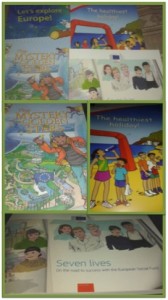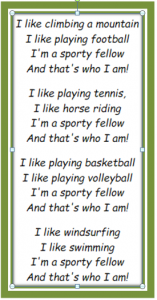Here we are again, dear colleagues, in front of our computer screens for hours, trying to do our best to cope with technology issues, as well as provide the optimum learning benefits in 30-minute synchronous online sessions with our learners. Although most of us have been through the same procedure last spring and are familiar with a variety of webtools and lots of theories regarding distance teaching and learning, most of us seem to feel drained after having racked our brains on how to be creative, present engaging tasks and accomplish our teaching goals in different classes for 15-24 sessions per week.
Networking with colleagues that experience the same situation has been uplifting and encouraging last spring and it proves to be valuable this time, too! Thanks to some online groups, sharing work and experiences has been led to levels that have been unfamiliar to our department – or at least how I experienced it back then! Being a warm supporter of sharing, here is part of a teaching scenario for the 1st and/or 2nd graders that has been applied and supported with positive feedback from learners, parents and myself who actually enjoyed it very much!
Subject:
English as a Second Language with a cross-curricular approach by means of ICT.
Connection with the curriculum:
Topic C4/C5 for the 1st grade / Topic B1 for the 2nd grade
Teaching context:
This scenario has been designed for synchronous online teaching to a class of 24 learners (1st grade) and a class of 24 learners (2nd grade) who are 6-7 years old and attend a rural Greek Primary School that has been shut down due to COVID-19 restrictions. Most of the learners are of Greek origin, come from mixed socio-economic backgrounds and there are no learners with diagnosed learning difficulties. None of the learners has any previous experience with online learning and parents have been advised to assist.
Level of Competence:
A1- level, according to the six-point scale of the Common European Framework of Reference for Languages.
Duration:
30 minutes of online learning and extra practice through asynchronous learning via e-class.
Transition:
This part of a teaching scenario has been designed for synchronous online learning by means of the webex platform. The particular learners have been taught in class the words “mummy” and “daddy” during the previous lesson and the activities of this part of the scenario have been designed for their first online session. All learners have no previous experience with webex online meetings; however, they have had sessions with their teacher the previous day. All learners have signed in the e-class of the Panhellenic School Network and have been using it since the beginning of the school year. They are not familiar with the web tools employed for this scenario (Thinglink, LearningApps, Video.link), but they are going to be guided into learning how to use them. Learners are supposed to own the necessary technological equipment for the session (internet connection, device, camera, microphone, speakers) and are invited to work as a group in order to complete the tasks.
Anticipated learning outcomes:
Learners are expected to achieve the following (based on the analytical indicators of communication competence):
A) Regarding English Language Competence
Listening skills:
- To answer simple questions in the foreign language (or more complex questions in Greek) concerning the content of a short speech, such as e.g. questions and answers (“Who’s this?” “Mummy”, etc.). (A1/22)
- To be able to understand very basic and standard expressions used in everyday interpersonal communication (eg greetings, such as “Hello, mummy!”, etc.). (A1/23)
- To be able to understand specific information (personal data of the speaker or information related to their immediate family environment), formulated with simple vocabulary and standard sentence structures. (A1/24)
Speaking skills:
- To be able to follow written or oral instructions in Greek to answer simple questions in the foreign language using standard expressions and simple vocabulary. (A1/39)
B) Regarding the use of technology
- To develop information and digital literacy through the process of locating, analyzing and, finally, utilizing information found in digital environments.
- To become familiar with the use of modules within the Electronic Classroom (e-class).
- To become familiar with new digital environments.
- To develop a responsible digital behavior through online collaboration with their peers (waiting for their turn, turning on and off their microphone when necessary, etc.).
C) Regarding the learning process and knowledge about the world
- To achieve linguistic literacy while receiving and producing in the target language.
- To develop visual literacy through digital visual stimuli.
- To encourage digital literacy through the navigation in the modules of the Electronic Classroom (e-class) and further familiarization with the use of particular web tools.
Detailed description:
1st activity: Introduction to the topic
Type of activity: Listening comprehension, speaking by means of singing and moving
Duration: 5’
Classroom organization: Working online as a group through webex platform.
Teachers’ role: Supportive, encouraging and coordinating.
Learners’ role (according to the Four Resources Model that was originally developed in 1990 by Peter Freebody and Allan Luke): The learner is invited to work as a text decoder, deciphering the code in written and visual stimuli, and as a text participant, in the sense that s/he attempts to comprehend the input and relate it to his/her previous knowledge.
Teacher’s actions: The teacher welcomes the learners to the new digital environment and introduces a picture in Thinglink, saying that it is going to help them revise what they had done during the previous lesson. The teacher clicks on the first red button at the bottom and starts with a video, in an attempt to link what has been taught with everything that is going to be introduced throughout the session. The learners watch part of a video with the heroes of Disney that refers to “mummy” and “daddy”. Learners are encouraged to sing along and move their hands and body in the way that has been introduced in class (they dance, wave hello at “hello” and shape a heart with their fingers at “I love you”).
Learners’ actions: Learners are welcomed in the new digital environment, watch the video, revise the words “Mummy”, “Daddy”, “I love you” and sing along, while moving their hands and body to the rhythm.
Digital educational content, web tools, resources:
Video.Link (16:27 – 18:38)
2nd activity: Vocabulary development
Type of activity: Listening and repeating
Duration: 5’
Classroom organization: Working online as a group through webex platform.
Teachers’ role: Supportive, encouraging and coordinating.
Learners’ role (according to the Four Resources Model that was originally developed in 1990 by Peter Freebody and Allan Luke): The learner is invited to work as a text decoder, deciphering the code in audio and visual stimuli, and as a text participant, in the sense that s/he attempts to comprehend the input and relate it to his/her previous knowledge.
Teacher’s actions: The teacher introduces the main picture of Thinglink and explains the use of the plus buttons (they have to click on the plus buttons and listen to how we say in English the members of the family). The teacher clicks on the plus buttons and encourages learners to listen and repeat.
Learners’ actions: Learners watch the picture and understand the content. They are introduced to a new web tool and they try to comprehend how it works. In the meantime, they listen and repeat, developing thus their vocabulary.
Digital educational content, web tools, resources:
3rd activity: Vocabulary Consolidation
Type of activity: Listening and choosing the correct word
Duration: 6’
Classroom organization: Working online as a group through webex platform.
Teachers’ role: Supportive, encouraging and coordinating.
Learners’ role (according to the Four Resources Model that was originally developed in 1990 by Peter Freebody and Allan Luke): The learner is invited to work as a text decoder, deciphering the code in audio and visual stimuli, as a text participant, in the sense that s/he attempts to comprehend the input and relate it to his/her previous knowledge and as a text user, as s/he uses it to complete the task.
Teacher’s actions: The teacher introduces the main picture of Thinglink again and explains the use of the red buttons at the bottom. Clicking on the second button, the teacher explains that, in order to complete the activity, learners have to listen to the words and choose the correct one for each pin on the family members’ faces. Learners are informed that they are going to do the task in turns and are encouraged to repeat the words as they listen.
Learners’ actions: Learners watch the picture with the pins and understand the procedure and target of the activity. They are introduced to a new web tool and they try to understand how it works. In the meantime, they listen and repeat, developing thus their vocabulary.
Digital educational content, web tools, resources:
4th activity: Vocabulary Consolidation
Type of activity: Matching the sound with the correct picture
Duration: 6’
Classroom organization: Working online as a group through webex platform.
Teachers’ role: Supportive, encouraging and coordinating.
Learners’ role (according to the Four Resources Model that was originally developed in 1990 by Peter Freebody and Allan Luke): The learner is invited to work as a text decoder, deciphering the code in audio and visual stimuli, as a text participant, in the sense that s/he attempts to comprehend the input and relate it to his/her previous knowledge and as a text user, as s/he uses it to complete the task.
Teacher’s actions: The teacher introduces the main picture of Thinglink again and explains the use of the red buttons at the bottom. Clicking on the third button, the teacher explains that, in order to complete the activity, learners have to match the sounds with the correct picture (memory card game). Learners are informed that they are going to do the task in turns and are encouraged to repeat the words as they listen. The teacher uses the annotation in order to number the cards and make it easier for the learners to choose a card (numbers can be introduced in English).
Learners’ actions: Learners watch the game with the memory cards and comprehend the procedure and the aim of the activity. They are introduced to a new web tool and they try to understand how it works. In the meantime, they have fun while trying to remember the images, the sounds and while listening and repeating, developing thus their vocabulary.
Digital educational content, web tools, resources:
5th activity: Vocabulary Consolidation
Type of activity: Singing and doing
Duration: 8’
Classroom organization: Working online as a group through webex platform.
Teachers’ role: Supportive, encouraging and coordinating.
Learners’ role (according to the Four Resources Model that was originally developed in 1990 by Peter Freebody and Allan Luke): The learner is invited to work as a text decoder, deciphering the code in audio and visual stimuli, as a text participant, in the sense that s/he attempts to comprehend the input and relate it to his/her previous knowledge and as a text user, as s/he uses it to complete the task.
Teacher’s actions: The teacher introduces the main picture of Thinglink again and reminds the use of the red buttons at the bottom. Clicking on the fourth button, the teacher explains that it is time to sing and dance. The teacher introduces the shark family and the movements they do with their mouth. Learners are invited to watch the video, sing and imitate the movements. The teacher plays the video at least twice and reminds the learners that everything they have worked with will be uploaded to their e-class for further practice.
Learners’ actions: Learners learn about the shark family and rehearse the movements sharks do with their mouth. They eventually watch the video, sing and imitate the movements presented. Throughout this activity they have fun while trying to remember the sounds and moving their hands and body.
Digital educational content, web tools, resources:
Normally, scenarios are described in a way that presents all anticipated outcomes of each activity and the presentation of the activities is followed by the evaluation of the scenario and its impact. However, at this point, I wouldn’t like to tire you with the norm and would prefer to share with you my thoughts and feelings, as a teacher!
Prior to evaluating my role throughout the activities, I wish I could share with you the enthusiasm of everyone involved throughout the lesson, the level of participation and the excitement, especially with the song that was presented in the end! We had our lesson on Friday (16:50-17:20) with A class and we actually said our goodbyes and wishes for the weekend at 17:35, as we played the song again and again! As for me, the teacher, all I had to do during the session was to sound encouraging, pay attention to the way I deliver instructions and make sure that microphones were on and off at the right times! It was a lesson I tried with both A and B classes and enjoyed very much and receiving emails and messages through social media from content and satisfied parents was the unexpected feedback that literally made my day!
We, teachers, spend a lot of time designing, creating and delivering in front of a computer screen these days and having a great session with our learners makes it all so worth it! Sharing this part of my teaching scenario with you, I want to contribute to this energetic community of admirable colleagues out there that burn the midnight oil with me these days and express my gratitude for all the support I get from groups of people that share the same experiences with me! I hope this teaching suggestion will be as useful as your contributions and sharing have been to me! Keep it up, dear colleagues and friends, and remember that teaching is our superpower and sharing is our secret weapon!






















